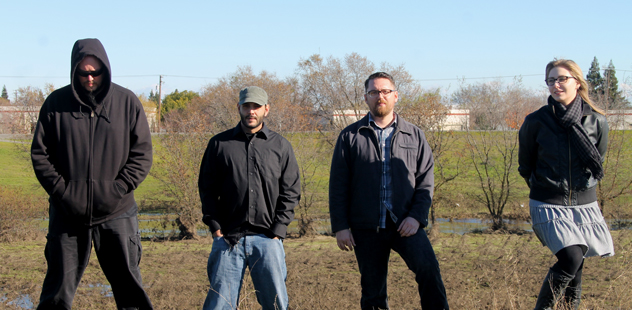 Photo by Kendall Tobe
Photo by Kendall Tobe
(waning) taps into Northern California folklore on their latest album The Funeral Mountains
A canopy of branches and leaves rustle softly; they whisper, almost in cadence, with the squeaks and chirps of Mother Nature’s most cherished creatures. Beyond these sounds, found deep within the sacred forest of the eastern Sierra Nevadas, dwells one woman with mystical powers and abilities. She belongs to an elder sisterhood of 4,000-year-old trees and possesses the gift to transform from human to the form of her ancient sisters—a shape-shifter. Sometime in the 1800s, one silver miner met eyes with this mysterious woman and was promised wealth and wisdom, but at a price. The miner, although enticed by the woman’s proposition, was unaware of the ulterior motives at large, wealth and wisdom for the lifelong promise to live alongside the woman as a tree forever. The choice was ultimately his and the story further unfolds within the latest, six-track album, The Funeral Mountains, from psychedelic doom metal band (waning).
Buriedinhell Records, based in Sacramento and operated by Kenneth Hoffman of local grind and punk bands like Knifethruhead and Cura Cochino, released (waning)’s first concept album in early January. The main idea behind The Funeral Mountains was not only inspired by native myths, California history and fairy tales, but sprung straight from the childhood dreams of keyboardist/vocalist Susan Hunt.
“One of the first things I can remember is having a dream that I was turning into a tree,” Hunt says over a pint at the Hideaway Bar and Grill. “I still remember that dream and it’s been a while. It was frightening.”
Frightening enough to inspire an album full of the band’s signature ambient tones and psychedelic spells, all compressed with an auditory heaviness arranged with the intent to inspire mood within a room full of listeners.
“Mood is really what dictates a lot of our music,” vocalist/guitarist Jim Willig explains. “We used to call ourselves doom a lot, and we do have a lot of slow songs, but the psychedelic or ambient element of the music is pervasive. There’s always been a hazy, trippy sort of vibe that we have cultivated, but we try and maintain the mood.”
Conceptualized in 2007, (waning) emerged when Willig nudged a reluctant Hunt to jump on a neglected keyboard she owned since youth. Hunt, with no formal training, was eventually convinced by Willig to give keys a chance in the form of “textural, weird sounds” with him on guitar at a noise fest in Eugene, Ore. As years progressed, so did the band’s song structures and a need to add more depth and opportunity for endless musical possibilities with the addition of percussion and bass guitar.
“I was not confident enough to play with real musicians because I’m not studied and I just sort of learned by the seat of my pants,” Hunt admits. “Then Jim bugged me into doing it. It’s taken a long time to gain some confidence and sort of move beyond that to contribute to a full band and challenge myself more.”
Now comfortable with her black and white keys, Hunt says the band is better than when it started and credits bassist/vocalist Ian Black and drummer Benjamin Carpineta. Black, a fan of (waning) before talks of joining surfaced during a Portishead concert, admits the slower, long-form style (waning) is known for was unlike any genre he’s ever experienced.
“Pretty much everything I’ve ever done before has been really up tempo, fast and aggressive,” Black says. “I was in an industrial band for 11 years and before that, I was in a couple punk bands [and] an ’80s-style hair metal band when I was 17.”
He adds, “This band’s music has always been really intense and powerful with a lot of beautiful aspects. It all works together and I haven’t been a part of any other band that has given me the same kind of feeling.”
In fact, feelings, moods and emotions are all sensations (waning) attempts to ignite during its live performances, which is what initially sparked the model for the band.
“I’ve wanted a band where if people close their eyes they don’t imagine people playing instruments, they imagine something else,” Willig says. “That’s why I talk about mood a lot and vastness. Transporting, that’s what we want to do.”
Sacramento loves noise—proven with an 18-season running event in the annual Norcal Noisefest. A mecca for all doom, noise, trance and experimentation, Noisefest hosts a mixed bag of genres, ranging from the more raucous sounds from bands such as Liver Cancer, to the more doom-oriented sounds (waning) emitted in 2007. Ultimately, the noise scene is where (waning) found its home—an odd and at times, raucous environment that allowed the band to express its creativity and gain inspiration for new techniques amid like-minded musicians.
“I’d say when we first started out we were really involved with the noise scene. Now, we’re primarily a part of the metal scene, which is almost an outgrowth of the punk or crust mentality. So, a lot of house shows, a bit more underground with a lot of people in their 30s and 40s,” Willig explains of the band’s new audience.
(waning), a band for the aged crusty at heart, who traded anarcho-punk for the contemporary doom metal scene.
Visit Waning.bandcamp.com to listen to their new album, The Funeral Mountains, and catch a live performance on Saturday, March 1, 2014 at the Café Colonial (3520 Stockton Boulevard) with The Body, Amarok and Plague Widow. The show starts at 8 p.m. and costs $10.


Comments